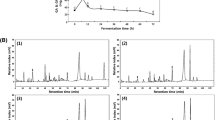Abstract
High value-added food materials were developed based on enhancement of phenolic contents in Cudrania tricuspidata leaves using fermentation of silkworm thorn leaves with Lactobacillus derived from Korean soybean paste. Ethanol extracts from fermentates were examined for antioxidant activities and flavonoid and corresponding glycoside contents. Radical scavenging activities were increased by approximately 20% after fermentation. Two prominent spectral peaks in fermentates that increased in size, compared with non-fermentates, were identified as quercetin (m/z 301.1) and kaempferol (m/z 285.3). Three peaks that decreased in size in fermentates were identified as quercetin-7-O-beta-glucopyranoside (m/z 463.1), kaempferol-3-O-beta-glucopyranoside (m/z 447.1), and kaempferol-7-O-beta-glucopyranoside (m/z 447.2). Conversion of flavonoid glycosides to flavonols, quercetin and kaempferol, occurred in silkworm thorn leaves due to fermentation with Lactobacillus.
Similar content being viewed by others
References
Nam S, Jang HW, Shibamoto T. Antioxidant activities of extracts from teas prepared from medicinal plants, Morus alba L., Camellia sinensis L., and Cudrania tricuspidata, and their volatile components. J. Agr. Food Chem. 60: 9097–9105 (2012)
Lee BW, Lee JH, Lee ST, Lee HS, Lee WS, Jeong TS, Park KH. Antioxidant and cytotoxic activities of xanthones from Cudrania tricuspidata. Bioorg. Med. Chem. Lett. 15: 5548–5552 (2005)
Joo HY, Lim KT. Glycoprotein isolated from Cudrania tricuspidata Bureau inhibits iNO and COX-2 expression through modulation of NF-kappaB in LPSstimulated RAW 264.7cells. Environ. Toxicol. Phar. 27: 247–252 (2009)
Lee BW, Lee JH, Gal SW, Moon YH, Park KH. Selective ABTS radical-scavenging activity of prenylated flavonoids from Cudrania tricuspidata. Biosci. Biotech. Bioch. 70: 427–432 (2006)
Lee YJ, Kim S, Lee SJ, Ham I, Whang WK. Antioxidant activities of new flavonoids from Cudrania tricuspidata root bark. Arch. Pharm. Res. 32: 195–200 (2009)
Hiep NT, Kwon J, Kim DW, Hwang BY, Lee HJ, Mar W, Lee D. Isoflavones with neuroprotective activities from fruits of Cudrania tricuspidata. Phytochemistry 111: 141–148 (2015)
Han XH, Hong SS, Jin Q, Li D, Kim HK, Lee J, Kwon SH, Lee D, Lee CK, Lee MK, Hwang BY. Prenylated and benzylated flavonoids from the fruits of Cudrania tricuspidata. J. Nat. Prod. 72: 164–167 (2009)
Choi SR, You DH, Kim JY, Park CB, Kim DH, Ryu J. Antioxidant activity of methanol extracts from Cudrania tricuspidata Bureau according to harvesting parts and time. Korean J. Med. Crop Sci. 17: 115–120 (2009)
Kim SH, Kim NJ, Choi JS, Park JC. Determination of flavonoid by HPLC and biological activities from the leaves of Cudrania tricuspidata Bureau. J. Korean Soc. Food Sci. Nutr. 22: 68–72 (1993)
Chon IJ, Lee SW, Cha JH, Han JH, Whang WK. Anti-oxidant compounds of Cudrania tricuspidata leaves. Yakhak Hoeji 49: 416–421 (2005)
Park JC, Young HS, Choi JS. Constituents of Cudrania tricuspidata in Korea. Yakhak Hoeji 36: 40–45 (1992)
Kim YS, Lee Y, Kim J, Kim J, Sohn E, Kim CS, Lee YM, Jo K, Shin S, Song Y, Kim JH, Kim JS. Inhibitory activities of Cudrania tricuspidata leaves on pancreatic lipase in Vitro and lipolysis in Vivo. Evid.-Based Compl. Alt. 2012: Article ID 878365 (2012)
Choi SR, You DH, Kim JY, Park CB, Kim DH, Ryu J, Choi DG, Park HM. Antimicrobial activity of methanol extracts from Cudrania tricuspidata bureau according to the parts harvested and time. Korean J. Medicinal Crop Sci. 17: 335–340 (2009)
Calderon-Montano JM, Burgos-Moron E, Perez-Guerrero C, Lopez-Lazaro M. A review on the dietary flavonoid kaempferol. Mini-Rev. Med. Chem. 11: 298–344 (2011)
Crozier A, Del Rio D, Clifford MN. Bioavailability of dietary flavonoids and phenolic compounds. Mol. Aspects Med. 31: 446–467 (2010)
Formica JV, Regelson W. Review of the biology of quercetin and related bioflavonoids. Food Chem. Toxicol. 33: 1061–1080 (1995)
Chen ZP, Sun J, Chen HX, Xiao YY, Liu D, Chen J, Cai H, Cai BC. Comparative pharmacokinetics and bioavailability studies of quercetin, kaempferol and isorhamnetin after oral administration of Ginkgo biloba extracts, Ginkgo biloba extract phospholipid complexes and Ginkgo biloba extract solid dispersions in rats. Fitoterapia 81: 1045–1052 (2010)
Graefe EU, Wittig J, Mueller S, Riethling AK, Uehleke B, Drewelow B, Pforte H, Jacobasch G, Derendorf H, Veit M. Pharmacokinetics and bioavailability of quercetin glycosides in humans. J. Clin. Pharmacol. 41: 492–499 (2001)
Kumar S, Pandey AK. Chemistry and biological activities of flavonoids: An overview. Sci. World J. 2013: Article ID 62750 (2013)
Wei QK, Chen TR, Chen JT. Using of Lactobacillus and Bifidobacterium to product the isoflavone aglycones in fermented soymilk. Int. J. Food Microbiol. 117: 120–124 (2007)
Marazza JA, Garro MS, de Giori GS. Aglycone production by Lactobacillus rhamnosus CRL981 during soymilk fermentation. Food Microbiol. 26: 333–339 (2009)
Lacikova L, Jancova M, Muselik J, Masterova I, Grancai D, Fickova M. Antiproliferative, cytotoxic, antioxidant activity and polyphenols contents in leaves of four Staphylea L. species. Molecules 14: 3259–3267 (2009)
Thaipong K, Boonprakob U, Crosby K, Cisneros-Zevallos L, Byrne DH. Comparison of ABTS, DPPH, FRAP, and ORAC assays for estimating antioxidant activity from guava fruit extracts. J. Food Compos. Anal. 19: 669–675 (2006)
Pyo YH, Lee TC, Lee YC. Enrichment of bioactive isoflavones in soymilk fermented with beta-glucosidase-producing lactic acid bacteria. Food Res. Int. 38: 551–559 (2005)
Tabasco R, Sanchez-Patan F, Monagas M, Bartolome B, Moreno-Arribas MV, Pelaez C, Requena T. Effect of grape polyphenols on lactic acid bacteria and bifidobacteria growth: Resistance and metabolism. Food Microbiol. 28: 1345–1352 (2011)
Wie HJ, Zhao HL, Chang JH, Kim YS, Hwang IK, Ji GE. Enzymatic modification of saponins from Platycodon grandiflorum with Aspergillus niger. J. Agr. Food Chem. 55: 8908–8913 (2007)
Landete JM, Curiel JA, Rodriguez H, de las Rivas B, Munoz R. Aryl glycosidases from Lactobacillus plantarum increase antioxidant activity of phenolic compounds. J. Funct. Food. 7: 322–329 (2014)
Author information
Authors and Affiliations
Corresponding author
Rights and permissions
About this article
Cite this article
Lee, Y., Oh, J. & Jeong, YS. Lactobacillus plantarum-mediated conversion of flavonoid glycosides into flavonols, quercetin, and kaempferol in Cudrania tricuspidata leaves. Food Sci Biotechnol 24, 1817–1821 (2015). https://doi.org/10.1007/s10068-015-0237-2
Received:
Revised:
Accepted:
Published:
Issue Date:
DOI: https://doi.org/10.1007/s10068-015-0237-2




